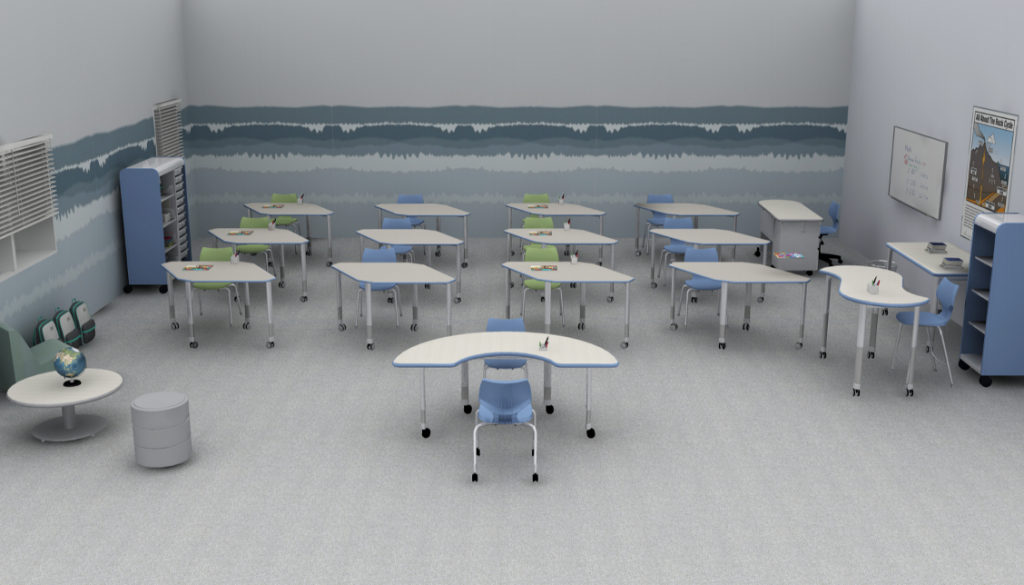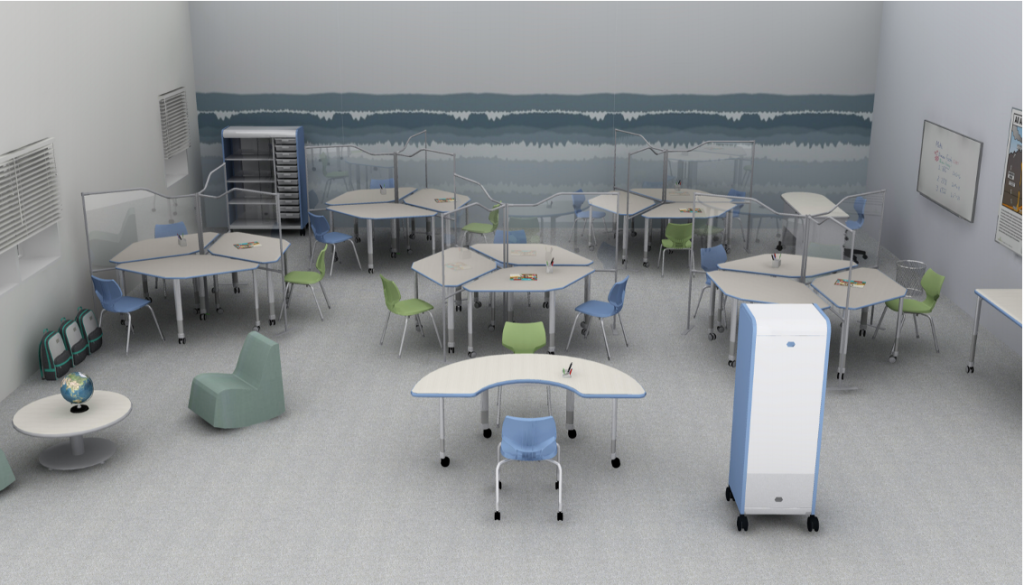
This blog originally appeared on Smith System’s blog.
Note: This story focuses solely on reconfiguring and retrofitting. Please see the most current version of interim guidelines from the U.S. Centers for Disease Control and Prevention (CDC) on how schools should handle safely reopening amid the coronavirus pandemic.
Among the uncertainly of COVID-19, one thing is for sure; the global pandemic has caused a permanent pivot in the K–12 educational landscape. At least for now. Returning to in-person learning requires seriously restructured classrooms and routines that help everyone be safe and feel safe.
We also know that real, live, face-to-face experiences will be very important. After all, education is more than just teaching and learning. It’s about conversation and community, the rich social-emotion interactions – from serious to silly – between and among students, educators, colleagues and parents.
There’s no one right answer to this safe-learning dilemma. Instead, this article aggregates current thinking by leading organizations and experts on using social distancing (or physical distancing) strategies in the classroom, while forging ahead with a holistic educational mission.
Well-being has a sweet spot. It happens at the intersection of our physical, cognitive and emotional health — with safety being foundational to all three. Schools must be supportive, connected communities that ensure safety exists:
Before COVID-19 hit the world full-force, modern learning spaces were designed to support active, engaged modes of learning. Educators emphasized student autonomy, fluid collaboration, and flexibility for a wide range of learning styles. Many of these attributes can now pose challenges, as we strive to limit close physical interactions and, thus, the spread of infection.
Educators, as well as architects and designers, need to rethink pre-COVID classroom characteristics:
So how can schools practice social distancing and maintain safe classroom spaces? Reconfiguring the classroom – or moving it entirely – is one approach, using flexible classroom design considerations like these:
Arrange students six feet apart (about two arms’ lengths, maybe three if those arms are little). Gain square footage wherever possible, like reducing teacher-only space. Also seat students to face one direction. Per the CDC, “Limiting face-to-face contact with others [who are not from your household] is the best way to reduce the spread of COVID-19.”
We all know this by now, but it doesn’t hurt repeating the CDC’s science. “Spread happens when an infected person coughs, sneezes, or talks, and droplets from their mouth or nose are launched into the air and land in the mouths or noses of people nearby. The droplets can also be inhaled into the lungs.”
Creating physical distance can also happen by repurposing larger spaces like the gym and cafeteria to accommodate more students. Then add desks and chairs. Teachers might also move classrooms outdoors for part of the day. Granted, these options can be unrealistic for some schools, due to overcrowding, lack of large indoor spaces, limited outdoor spaces, or outdoor spaces that are not safe and/or comfortable for everyone.
Schools can rearrange classroom furniture to create six feet of physical distance. Doing so also gives students a visual reminder to respect the radius. If furnishings have casters, keep those in locked position to help prevent “COVID creep.”
For educators who need layout suggestions, Smith System has created sample classroom floorplans that support multiple learning models with physical distance. Each diagram shows seating, tables, desk and storage diagrams, along with traffic-flow arrows, based on classroom square footage and number of students.
The floorplans also map out how schools can use their existing Smith System classroom furniture as dual-purpose solutions. For example:
Speaking of furniture, it goes without saying that surfaces and materials should be easy to clean. Smith offers simple guidelines for how to clean its school furnishings, from the company’s fun vinyl-fabric lounge seating to its workhorse whiteboards.


Retrofitting classrooms is about creating division using screens, panels, sneeze guards, partitions or other barriers where physical distancing is a challenge. Schools can easily move these around or remove them as safety concerns change.
Smith System offers three new options to create barriers. They include clear desktop barrier screens and standing barrier screens to place between students. Both light-weight options are designed to separate work stations into safe individual zones. The impact-resistant screen provides a clear view around the students, while defending against droplets from others nearby. Students can still collaborate together in the classroom, with a protective, transparent barrier to avoid direct contact. Desktop screens come fully assembled, ready to use in sizes (inches) 18×24, 20×27 and 24×27. The freestanding barrier screen is 14×58.5×50.5.
The third option is basic 3D printable plastic barrier stands that students or schools can make by downloading Smith System’s free design file for 3D printers. After printing the stands, students simply slide any type of firm material into the slots, like cardboard, to create an upright barrier.
Without question, guarding against the transmission of COVID-19 will be a massive and potentially costly challenge for educational leaders. A recent article in Education Week stated it best, “[Schools] will have to rethink every space inside and outside their buildings.” Smith System is here to help. As education’s new normal continues to evolve, we’ll continue to stay thoughtful and deliberate in helping preK-12 schools move forward with safe learning.

With a reputation for legendary design and top-quality construction, Smith System manufactures furniture exclusively for learning spaces. The Smith System contract includes traditional and casual seating options, student and teacher desks, collaboration tables, multi-purpose classroom storage, book carts, and outdoor furniture, and is available through Steelcase dealers nationwide.